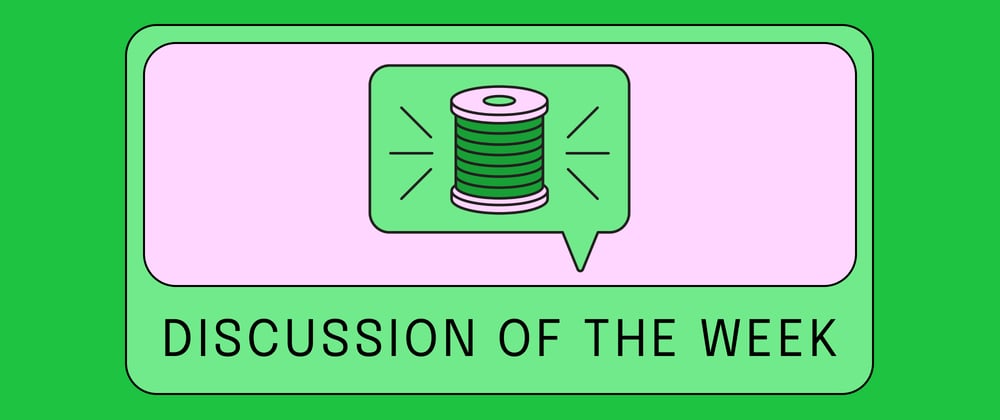In this weekly roundup, we highlight what we believe to be the most thoughtful, helpful, and/or interesting discussion over the past week! Though we are strong believers in healthy and respectful debate, we typically try to choose discussions that are positive and avoid those that are overly contentious.
Any folks whose articles we feature here will be rewarded with our Discussion of the Week badge. ✨
Now that y'all understand the flow, let's go! 🏃💨
The Discussion of the Week
This week's featured discussion goes to @jmfayard for initiating a super helpful conversation titled "The IT job market is tough right now. What are your best tips to create a developer portfolio ?"

The IT job market is tough right now. What are your best tips to create a developer portfolio ?
Jean-Michel 🕵🏻♂️ Fayard ・ Jan 26
A continuation of the excellent series Hiring Is Broken, Jean-Michel opens this entry by covering the challenges that devs face in today's job market before arguing that developers should spend more time working on their portfolios. Explaining that a portfolio provides a dev a special opportunity to stand out to hiring managers, Jean-Michael opens the floor with the following prompt:
What are your best tips to create a developer portfolio?
Right up at the top of the comments section sits some fantastic advice from @brian_curricular who points out that hiring managers and interview panelists rarely have much time to look through a portfolio, so succinctness and functionality must take the forefront:
Hiring managers and interview panelists don't spend more than a couple minutes looking at a portfolio. Two reasons: 1) They don't have much time to evaluate you or your projects, and 2) most portfolios look the same (short bio, a few stock photos, links to some clone sites).
So in most cases, the portfolio evaluation is about two things: "Does the portfolio exist?" and "Is there anything off in the design or content of this portfolio so I can disqualify the candidate?"
A portfolio should be simple and functional - introduce yourself and your work, very few bells and whistles. Make the design crisp and with personality, but professional.
I'm working on a separate post about the types of projects developers should have in a portfolio. But if you've built something with active users, or to support a client's line of business, that beats a practice project any day.
We'll be keeping an eye out for your article, Brian!
@colocodes weighs in with some wonderful step-by-step guidance while pointing to a related post that they previously shared called "How I’ve got a web development job one week after publishing my portfolio".
I wrote about this a while ago, but I think the ideas are still valid today. To maximise the chances of getting hired, a portfolio needed to include:
0️⃣ A custom domain name. In my case, damiandemasi.com was available, so I took it. I also registered the colo.codes domain, as it's my nickname on social networks.
1️⃣ A catching hero section with immediate calls to action in the way of a “contact me” button and an option to download my resume.
2️⃣ A projects section with at least two projects. This section should also include links to the live versions of the projects, as well as a GIF or video of the project being used (a sort of demo), and a description of the process I followed to create the project. The objective of all of this is to show how we approach coding challenges, the decisions we make, and how we deal with problems.
3️⃣ A blog section with at least three articles. These articles should display how we address the description of technical concepts, and how well (or bad) we communicate in English (when it is not our native language).
4️⃣ An about me section, with easy and clear ways to access our LinkedIn profile, as well as the resume, GitHub profile, and Twitter/X. Even though our resume could have been accessed from the hero section, I believe having redundancy (without spamming) is a way to ensure the important parts of the portfolio (like the resume) aren’t overlooked. In my case, I went full-on honest mode in this section and presented myself as I am. By doing so, I could push away employers that were not compatible with my personality and attract the ones that really liked how I am, thus speeding up the job selection process. I also briefly highlighted the technologies I was familiar with. In the end, this proved to be a correct approach, because both, the COO and CEO of the company that hired me mentioned that they loved how I presented myself online.
5️⃣ A social proof (reviews) section to demonstrate that we have a proven track record as an employee and team member. We can I use our LinkedIn recommendations as the source material for building this, and provide links to our LinkedIn profile so potential employers could see we are not being dishonest.
6️⃣ And finally, a contact section. In it, we could offer three different ways of contact: an email address, a LinkedIn link, and a completely functional form (using Netlify, for example). People have different preferences when it comes to contacting a potential employee, so we want to offer as much flexibility as feasible.
You can read more about this here: dev.to/colocodes/how-ive-got-a-web...
Meanwhile, @j3ffjessie counters the premise, pointing out that portfolios aren't all that important and asserts that a dev's time is probably better spent on networking:
This is going to sound rough or horrible, but a portfolio doesn’t really matter. Hiring managers don’t have the time to look over your portfolio for a majority of positions. They just don’t. They have real work to do and they get your CV in an email from HR saying take a look and let me know if you want to interview them. They glance your CV to look for anything that immediately disqualifies and then your skills.
The more important thing to land a job when the market is how it is right now is networking. Intentionally connecting with individuals and cultivating conversation. Don’t just blast out connections and ask for help getting a job. Intentionally connect with people at companies you want to work for. Comment something you like about the company or product or something you are interested in about the company and actually build a connection with individuals. If you have skills that are good they can help connect you and refer you to positions. Cold applying and hoping do not work like they used to.
This is just a sampling — the comments don't stop there! Also, props to Jean-Michel for being so thoughtful and respectful in their responses. Great job keeping the discussion (and the good vibes) rolling! 🙌
If you have any thoughts about how to improve a dev portfolio or other tips for getting hired, don't hesitate to hop in and share them in the comments section.
What's your pick for the Discussion of the Week?
The DEV Community is particularly special because of the kind, thoughtful, helpful, and entertaining discussions happening between community members. As such, we want to encourage folks to participate in discussions and reward those who are initiating or taking part in conversations across the community. After all, a community is made possible by the people interacting inside it.
There are loads of great discussions floating about in this community. This is just the one we chose to highlight. 🙂
I urge you all to share your favorite discussion of the past week below in the comments. And if you're up for it, give the author an @mention — it'll probably make 'em feel good. 💚











Top comments (0)
Some comments may only be visible to logged-in visitors. Sign in to view all comments.